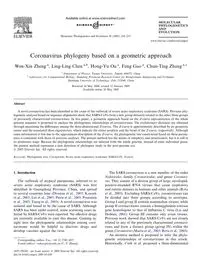
2005 Coronavirus phylogeny based on a geometric approach PDF
Preview 2005 Coronavirus phylogeny based on a geometric approach
Coronavirus phylogeny based on a geometric approach Wen-Xin Zheng a, Ling-Ling Chen a,b, Hong-Yu Ou a, Feng Gao a, Chun-Ting Zhang a,* a Department of Physics, Tianjin University, Tianjin 300072, China b Laboratory for Computational Biology, Shandong Provincial Research Center for Bioinformatic Engineering and Technique, Shandong University of Technology, Zibo 255049, China Received 24 May 2004; revised 12 January 2005 Available online 10 May 2005 Abstract A novel coronavirus has been identified as the cause of the outbreak of severe acute respiratory syndrome (SARS). Previous phy- logenetic analyses based on sequence alignments show that SARS-CoVs form a new group distantly related to the other three groups of previously characterized coronaviruses. In this paper, a geometric approach based on the Z-curve representation of the whole genome sequence is proposed to analyze the phylogenetic relationships of coronaviruses. The evolutionary distances are obtained through measuring the differences among the three-dimensional Z-curves. The Z-curve is approximately described by its geometric center and the associated three eigenvectors, which indicate the center position and the trend of the Z-curve, respectively. Although some information is lost due to the approximate description of the Z-curve, the phylogenetic tree constructed based on these param- eters is consistent with those of previous analyses. The present method has the merits of simplicity and intuitiveness, but it is still in its premature stage. Because the phylogenetic relationships are inferred from the whole genome, instead of some individual genes, the present method represents a new direction of phylogeny study in the post-genome era. � 2005 Elsevier Inc. All rights reserved. Keywords: Phylogenetic tree; Coronavirus; Severe acute respiratory syndrome; SARS-CoV; Z-curve 1. Introduction The outbreak of atypical pneumonia, referred to as severe acute respiratory syndrome (SARS) was first identified in Guangdong Province, China, and spread to several countries later (Drosten et al., 2003; Ksiazek et al., 2003; Lee et al., 2003; Peiris et al., 2003; Poutanen et al., 2003; Tsang et al., 2003). A novel coronavirus was isolated and found to be the cause of SARS. Although SARS has been under control, some scattering cases in- fected by SARS-CoVs were reported. No effective drugs are currently available to cure this disease. Gaining in- sight into the phylogenetic relationships among coro- naviruses would be helpful to discover drugs and develop vaccines against the virus. The SARS-coronavirus is a new member of the order Nidovirales, family Coronaviridae, and genus Coronavi- rus. They consist of a diverse group of large, enveloped, positive-stranded RNA viruses that cause respiratory and enteric diseases in humans and other animals (Rota et al., 2003). Excluding SARS-CoVs, coronaviruses can be divided into three groups according to serotypes. Group I and group II contain mammalian viruses, while group II coronaviruses contain a hemagglutinin esterase gene homologous to that of Influenza C virus (Lai and Holmes, 2001). Group III contains only avian viruses. Previous work showed that SARS-CoVs are not closely related to any of the previously characterized coronavi- ruses and form a distinct group (group IV) within the genus Coronavirus (Marra et al., 2003; Rota et al., 2003). An intuitive method is proposed to infer the phylo- genetic relationships of coronaviruses in this article. Historically, Cork et al. proposed a three-dimensional 1055-7903/$ - see front matter � 2005 Elsevier Inc. All rights reserved. doi:10.1016/j.ympev.2005.03.030 * Corresponding author. Fax: +86 22 2740 2697. E-mail address:
